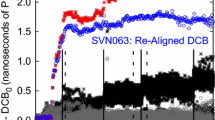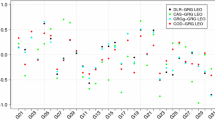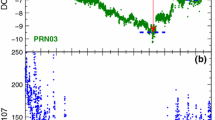Abstract
Precise estimation of satellite differential code biases (DCBs) plays a crucial role in precise ionospheric modeling, positioning, and timing. Due to the rank deficiency, a constraint or a datum is required in order to separate the satellite DCBs from the receiver DCBs. A common practice is to impose a zero-mean constraint on all the visible satellites. However, datum selection is affected by satellite replacement and variation of the DCBs. As a result, the long-term variations of current DCB products vary significantly. Taking the DCBs of SVN 44 (PRN 28) as a reference, we analyzed the long-term variations of DCBs over a period of 20 years, between 2000 and 2019. Based on this reference, the results indicate that the change of the zero-mean datum is responsible for the variation of current DCB products. The datum change is attributed to the satellite replacement as well as the discontinuities and their variations. We found that discontinuities for the same satellite vehicle reach 1.8 ns, which is related to satellite changes announced in the Notice Advisory to Navstar Users message and to flex power. The magnitude of the DCBs depends on the satellite type. DCBs for Block IIR-A and IIR-M satellites are close to each other, while DCBs of Block IIR-B satellites are approximately 5 ns larger and DCBs for the Block IIF are 8 ns smaller. In addition, the satellite biases between GPS P1 and C1 are also briefly examined, and the results show that they are also affected by the satellite replacements and discontinuities. However, the satellite bias differences between P1 and C1 for different satellite types are minor.















Similar content being viewed by others
References
Banville S, Zhang W, Ghoddousi-Fard R, Langley RB (2012) Ionospheric monitoring using “integer-levelled” observations. In: Proceedings of the ION GNSS 2012, Institute of Navigation. Nashville, Tennessee, USA, September 17–21, pp 2692–2701
Coco DS, Coker C, Dahlke SR, Clynch JR (1991) Variability of GPS satellite differential group delay biases. IEEE Trans Aerosp Electron Syst 27(6):931–938. https://doi.org/10.1109/7.104264
Coster A, Williams J, Weatherwax A, Rideout W, Herne D (2013) Accuracy of GPS total electron content: GPS receiver bias temperature dependence. Radio Sci 48(2):190–196. https://doi.org/10.1002/rds.20011
Dach R, Hugentobler U, Fridez P, Meindl M (2015) Bernese GPS software version 5.2. Astronomical Institute, University of Bern
Gao Y, Lahaye F, Héroux P, Liao X, Beck N, Olynik M (2001) Modeling and estimation of C1–P1 bias in GPS receivers. J Geod 74(9):621–626
Hauschild A, Montenbruck O (2016) A study on the dependency of GNSS pseudorange biases on correlator spacing. GPS Solut 20(2):159–171
Hegarty CJ, Powers ED, Fonville B (2005) Accounting for timing biases between GPS, modernized GPS, and Galileo signals. In: Proceedings of the ION GNSS 2005, Institute of Navigation. Long Beach, CA, US, September 16–19, pp 2401–2407
Hernández-Pajares M, Juan JM, Sanz J, Orus R, Garcia-Rigo A, Feltens J, Komjathy A, Schaer SC, Krankowski A (2009) The IGS VTEC maps: a reliable source of ionospheric information since 1998. J Geod 83(3–4):263–275
Levine J (2008) A review of time and frequency transfer methods. Metrologia 45(6):S162
Li H, Li B, Lou L, Yang L, Wang J (2016) Impact of GPS differential code bias in dual- and triple-frequency positioning and satellite clock estimation. GPS Solut. https://doi.org/10.1007/s10291-016-0578-1
Li M, Yuan Y, Wang N, Li Z, Li Y, Huo X (2017) Estimation and analysis of Galileo differential code biases. J Geodesy 91(3):279–293
Li Z, Yuan Y, Li H, Ou J, Huo X (2012) Two-step method for the determination of the differential code biases of COMPASS satellites. J Geod 86(11):1059–1076
Mannucci AJ, Wilson BD, Yuan DN, Ho CH, Lindqwister UJ, Runge TF (1998) A global mapping technique for GPS-derived ionospheric total electron content measurements. Radio Sci 33(3):565–582
Montenbruck O, Hauschild A, Steigenberger P (2014) Differential code bias estimation using multi-GNSS observations and global ionosphere maps. Navigation 61(3):191–201
Ray J, Senior K (2005) Geodetic techniques for time and frequency comparisons using GPS phase and code measurements. Metrologia 42(4):215–232
Rovira-Garcia A, Juan JM, Sanz J, Gonzalez-Casado G (2015) A worldwide ionospheric model for fast precise point positioning. IEEE Trans Geosci Remote Sens 53(8):4596–4604
Sardón E, Zarraoa N (1997) Estimation of total electron content using GPS data: how stable are the differential satellite and receiver instrumental biases? Radio Sci 32(5):1899–1910
Steigenberger P, Thölert S, Montenbruck O (2019) Flex power on GPS block IIR-M and IIF. GPS Solut 23(1):8
Tu R, Zhang P, Zhang R, Liu J, Lu X (2019) Modeling and performance analysis of precise time transfer based on BDS triple-frequency un-combined observations. J Geod 93(6):837–847
Villiger A, Schaer S, Dach R, Prange L, Sušnik A, Jäggi A (2019) Determination of GNSS pseudo-absolute code biases and their long-term combination. J Geod 93(9):1487–1500. https://doi.org/10.1007/s00190-019-01262-w
Wang N, Yuan Y, Li Z, Montenbruck O, Tan B (2016) Determination of differential code biases with multi-GNSS observations. J Geod 90(3):209–228
Wanninger L, Sumaya H, Beer S (2017) Group delay variations of GPS transmitting and receiving antennas. J Geod 91(9):1099–1116
Xiang Y (2018) Carrier phase-based ionospheric modeling and augmentation in uncombined precise point positioning. Dissertation, University of Calgary, Calgary, Canada
Xiang Y, Gao Y (2017) Improving DCB estimation using uncombined PPP. Navigation 64(4):463–473
Yuan Y, Ou J (2004) Generalized trigonometric series function model for determining ionospheric delay. Prog Nat Sci 14(11):1010–1014
Zhang B, Teunissen PJG, Yuan Y (2017) On the short-term temporal variations of GNSS receiver differential phase biases. J Geod 91(5):563–572
Zhang BC, Ou JK, Bin YY, Li ZS (2012) Extraction of line-of-sight ionospheric observables from GPS data using precise point positioning. Sci China Earth Sci 55(11):1919–1928
Zhang D, Shi H, Jin Y, Zhang W, Hao Y, Xiao Z (2014) The variation of the estimated GPS instrumental bias and its possible connection with ionospheric variability. Sci China Technol Sci 57(1):67–79
Zhao L, Ye S, Song J (2017) Handling the satellite inter-frequency biases in triple-frequency observations. Adv Space Res 59(8):2048–2057. https://doi.org/10.1016/j.asr.2017.02.002
Zhong J, Lei J, Dou X, Yue X (2016a) Is the long-term variation of the estimated GPS differential code biases associated with ionospheric variability? GPS Solut 20(3):313–319
Zhong J, Lei J, Yue X, Dou X (2016b) Determination of differential code bias of GNSS receiver onboard low earth orbit satellite. IEEE Trans Geosci Remote Sens 54(8):4896–4905
Acknowledgements
DCB products downloaded from CODE and NANU information are gratefully acknowledged. We also thank anonymous reviewers for their useful comments and suggestions on the research that led to this manuscript. Special thanks to IEEE life fellow Trieu-Kien Truong and Daniele Sartori’s proofreading. The study is supported by the science and technology project of State Grid Corporation of China (No. SGSHJX00KXJS1901531).
Author information
Authors and Affiliations
Corresponding authors
Additional information
Publisher's Note
Springer Nature remains neutral with regard to jurisdictional claims in published maps and institutional affiliations.
Rights and permissions
About this article
Cite this article
Xiang, Y., Xu, Z., Gao, Y. et al. Understanding long-term variations in GPS differential code biases. GPS Solut 24, 118 (2020). https://doi.org/10.1007/s10291-020-01034-6
Received:
Accepted:
Published:
DOI: https://doi.org/10.1007/s10291-020-01034-6




